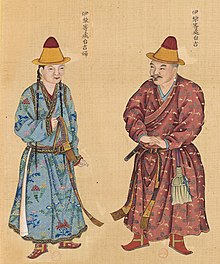
Back Джунгар Bulgarian Džúngarové Czech Ĝungaroj Esperanto Zúngaros Spanish جونغارها Persian Dzoungars French ज़ुन्गार लोग Hindi Suku Dzungar ID Zungari Italian Жоңғарлар Kazakh
ᠵᠡᠭᠦᠨᠭᠠᠷ | |
|---|---|
 | |
| Total population | |
| 658,372-668,372 | |
| Regions with significant populations | |
| 250,000 (2013 estimate) | |
| 205,000 (2010 census) | |
| 183,372 (Kalmyk)[1] | |
| 12,000 (Kalmyk)[2] | |
| 325 (Kalmyk)[3] | |
| 1,500 (Kalmyk)[4] | |
| Languages | |
| Oirat, Chagatai | |
| Religion | |
| Tibetan Buddhism | |
| Dzungar people | |||||||||||
|---|---|---|---|---|---|---|---|---|---|---|---|
| Chinese name | |||||||||||
| Traditional Chinese | 準噶爾 | ||||||||||
| Simplified Chinese | 准噶尔 | ||||||||||
| |||||||||||
| Mongolian name | |||||||||||
| Mongolian Cyrillic | Зүүнгар, Mongolian pronunciation: [tsuːŋˈɢɑr] | ||||||||||
| Mongolian script | ᠵᠡᠭᠦᠨᠭᠠᠷ | ||||||||||
| Kazakh name | |||||||||||
| Kazakh | Жоңғар [ʑwʊɴˈʁɑɾ] Joñğar جوڭگار | ||||||||||
The Dzungar people (also written as Zunghar or Junggar; from the Mongolian words züün gar, meaning 'left hand') are the many Mongol Oirat tribes who formed and maintained the Dzungar Khanate in the 17th and 18th centuries. Historically, they were one of the major tribes of the Four Oirat confederation. They were also known as the Eleuths or Ööled, from the Qing dynasty euphemism for the hated word "Dzungar",[5] and as the "Kalmyks". In 2010, 15,520 people claimed "Ööled" ancestry in Mongolia.[6] An unknown number also live in China, Russia and Kazakhstan.
- ^ Итоги ВПН 2010 Archived 2016-06-05 at the Wayback Machine All Russian census, 2010
- ^ "PRESIDENT.MN". Archived from the original on 6 December 2016. Retrieved 4 December 2016.
- ^ State statistics committee of Ukraine – National composition of population, 2001 census (Ukrainian)
- ^ Guchinova, Elsa-Blair M. (Fall 2002). "Kalmyks in the United States". Anthropology & Archeology of Eurasia. 41 (2): 8. doi:10.2753/AAE1061-195941027. S2CID 144027029. Retrieved 2023-04-25.
- ^ C.P. Atwood-Encyclopedia of Mongolia and the Mongol Empire, p. 425
- ^ "National Census 2010 of Mongolia" (PDF). Archived from the original (PDF) on 2011-09-15.
© MMXXIII Rich X Search. We shall prevail. All rights reserved. Rich X Search